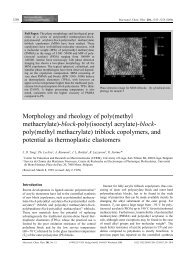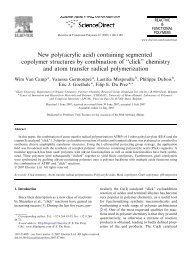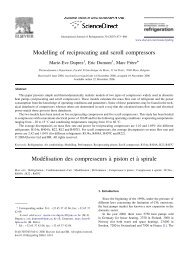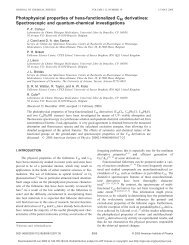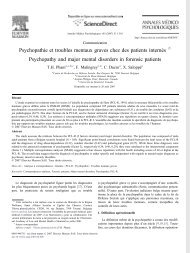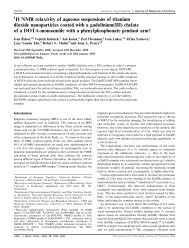Definitive characterization of some C5H5N and C radical cations by ...
Definitive characterization of some C5H5N and C radical cations by ...
Definitive characterization of some C5H5N and C radical cations by ...
You also want an ePaper? Increase the reach of your titles
YUMPU automatically turns print PDFs into web optimized ePapers that Google loves.
96 P. Gerbaux et al./International Journal <strong>of</strong> Mass Spectrometry 206 (2001) 91–103<br />
Fig. 2. Ion–molecule reactions between 1a <strong>radical</strong> <strong>cations</strong> (m/z 79) <strong>and</strong> tert-butyl isocyanide: (a) mass spectrum <strong>of</strong> the ions produced in the<br />
quadrupole collision cell <strong>and</strong> (b) subsequent collision-induced dissociation (O 2 8000 eV) <strong>of</strong> the m/z 105 ions. Ion–molecule reactions between<br />
pyridine <strong>radical</strong> <strong>cations</strong> 1 (m/z 79) <strong>and</strong> tert-butyl isocyanide: (c) subsequent collision-induced dissociation (O 2 8000 eV) <strong>of</strong> the m/z 105<br />
ions.<br />
In contrast to its inertness in reactions with water<br />
<strong>and</strong> methanol discussed in Sec. 3.3, the pyridine<br />
molecular ions 1 do react with tert-butyl isocyanide,<br />
generating ions at m/z 57 <strong>and</strong> m/z 105. However, these<br />
reactions are clearly less efficient than those observed<br />
with the distonic ion 1a . Although the signal at m/z<br />
105 represents 3.5% <strong>of</strong> the base peak (m/z 79) when<br />
ions 1a are transmitted to the quadrupole cell, this<br />
yield decreases to about 0.4% with the molecular ions<br />
<strong>of</strong> pyridine. Moreover, a consecutive CID experiment,<br />
see Fig. 2(c), reveals that the m/z 105 ions generated<br />
from ionized pyridine do not have the protonated<br />
2-cyanopyridine structure. These ions rather represent<br />
a less stable N-cyano species which is prone to lose<br />
CN (m/z 79).<br />
3.5. Ion–molecule reactions with isopropyl iodide<br />
Scheme 4.<br />
Alkyl iodides have relatively low homolytic CI<br />
bond dissociation energies, in the 170–250 kJ/mol<br />
range [23]. Iodine atom abstraction is therefore <strong>of</strong>ten<br />
observed when free alkyl <strong>radical</strong>s are allowed to react



